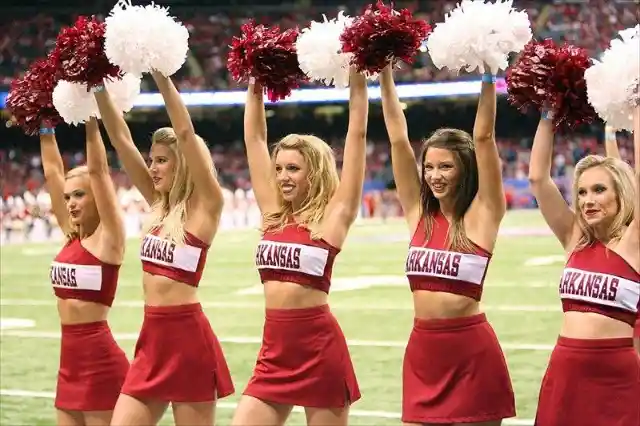Douglas, Arizona
Arizona is one of the states in the U.S. that are experiencing a boom in population. However, not every city is growing. In fact, Douglas’ population has been shrinking in recent years.


Between 2010 and 2018, its population dropped by 2,000 residents. It is believed that its crime rate is responsible for this.
St. Louis, Missouri
St. Louis, Missouri, used to be one of the largest cities in the U.S. when it came to population. In fact, it was in the top-ten largest cities in the country.


Due to a variety of reasons, the city has seen a 64% drop in population since the 1950s, and this number just keeps getting higher. In the last ten years, it has dropped by 5%.
Lovelock, Nevada
Nevada’s population has been booming for a while, but this increase in population has not reached Lovelock yet. In fact, the town has been losing inhabitants for years.


It is estimated that 17.5% of its inhabitants have moved out of Lovelock while Las Vegas’ population increased by 10%. The city has received a federal grant of $600,000 to attract new residents.
Corcoran, California
California’s population has increased a lot over the years, but that growth is starting to slow down now. Cities like Corcoran are losing inhabitants instead of gaining them nowadays.


The city’s population dropped by 12% in recent years and it is believed that it is due to California’s increasingly high taxes. That, combined with the fact that it is a very small town, has left Corcoran with only 21,000 residents.
Baker City, Oregon
Oregon is one of the fastest-growing states in the country. More and more people are moving to this state each year and finding a home in one of its biggest cities.


Oregon’s small towns, however, are actually getting smaller. Baker City has recently lost 0.7% of its residents and that number is only going to grow in the future.
Cordele, Georgia
Cordele is a very small town in Georgia that has been getting smaller and smaller with every passing year. The problem has gotten so serious that its government has tried different strategies to stop it from happening.


Within eight years, the population went from 11,608 to 10,638 inhabitants. The government is planning on lowering taxes to attract more people.
Selma, Alabama
The city of Selma, Alabama, is very famous for its history. Its inhabitants were heavily involved in the Civil Rights Movement in the 1960s and also created the Selma Voting Rights Movement.


However, people have actually been leaving the city since the 1960s. From 2010 to 2018, the population dropped by 13.8% and is expected to keep dropping in the coming years.
Honolulu, Hawaii
Honolulu is Hawaii’s most famous city, so it may come as a surprise to see it on this list. Why would its inhabitants want to leave? The answer is simple: the living costs in the city are too high.


Honolulu has lost 11.1% of its population in recent years due to its high living costs. In fact, living there is 30% more expensive than living in Austin, Texas.
Gladeview, Florida
Gladeview used to be a part of Miami until the Great Depression, when a change in jurisdiction made it a separate city. This made the city’s population drop while Miami got bigger and bigger.


The city’s rate of shrinking has accelerated since the 1980s. It now has 11,535 inhabitants and it is expected to be reduced to 10,000 soon.
Sterling, Colorado
Sterling, Colorado, has been shrinking for years while the rest of the state experienced a population boom. It is unclear why this city in particular has been losing residents.


Sterling saw a 7.9% drop in inhabitants since 2010. However, there was a job growth of 0.7% in 2019, which might attract new residents in the near future.
Norwich, Connecticut
Connecticut has been losing inhabitants for years, but Norwich has seen the biggest impact of population decline in the whole state.


After experiencing a 12.1% increase in population in the 1960s, the number started to decline. It has lost an estimated 3% of its residents since then.
Niagara Falls, New York
Niagara Falls, New York is one of the biggest tourist attractions in the United States, but when it comes to people living there, it’s not big at all.


The city has been losing residents since the 1950s and it was estimated that its population dropped by 4.1% since 2010. It is believed that the decline of the heavy industry had a lot to do with the problem.
Baltimore, Maryland
Baltimore is definitely one of the most recognizable cities in all of the United States. Not only that, but it is also the most populous city in the state of Maryland.


Since the 1950s, the city’s population has been in decline. Between 2018 and 2019, the city’s population dropped by 1.2%, and it is expected to keep dropping.
Ocean City, New Jersey
Ocean City, New Jersey relies heavily on tourism. Many tourists love visiting the city every summer, but getting people to actually move there is a whole other story.


In fact, the population dropped by 23.9% from 2000 to 2010 and has dropped another 5.6% since then. It is believed that this is due to the rising living costs of the area.
Jackson, Mississippi
Many people are leaving Mississippi for a number of reasons, from lack of jobs to fewer leisure choices. Jackson is struggling the most in this situation.


The unemployment rate in the state is higher than the national average, and Jackson has been greatly affected by it. Its population has shrunk by 5.2% since 2010.
Lawton, Oklahoma
Lawton used to be Oklahoma’s third-largest city once upon a time. But times have changed, and the city has experienced a drop in population it had never seen before.


Fort Sill was annexed to Lawton to bring the city back to life, and while there was an increase in population, it was only temporary.
Goldsboro, North Carolina
You may have heard of Goldsboro, North Carolina due to a horrific accident that took place in the 1960s, in which a plane carrying nuclear bombs exploded, dropping two nuclear bombs in the process.


Neither bomb exploded, but there is a chance that any bomb could go off at any time. This has prompted people to leave the city since then and has caused its population to drop by 6%.
Flint, Michigan
Flint, Michigan, has suffered a major drop in population in recent years for several reasons. The biggest cause of this issue is the water crisis that is still going on to this day.


Another reason was the downsizing of General Motors, a company that employed thousands of inhabitants of the city. It is estimated that Flint has lost half of its population since the 1960s.
Newport, Kentucky
Newport has been the urban center for the north of Kentucky for generations. However, it has been in decline for several decades now.


The city has been shrinking since the 1950s and is now losing inhabitants at a faster rate than ever. In fact, the population dropped by 10% in just ten years.
Shreveport, Louisiana
Shreveport is the third-most-populated city in all of Louisiana, and yet, its population has shrunken by 5.2% since 2010, which is a cause for concern.


This issue caught the eye of the local government, which conducted a census to really figure out what's going on. It is said that the city is coming up with plans to stop the city from shrinking.
Youngstown, Ohio
Youngstown, Ohio saw a boom in population during the 1950s thanks to the steel industry. However, this didn’t last long and the numbers started dwindling only a few years later.


The number of inhabitants dropped by 3% in only one year, between 2017 and 2018. It is believed that this is due to a lack of job opportunities.
Johnstown, Pennsylvania
Johnstown, Pennsylvania was a booming city in the 1930s. Back then, it had a population of 65,000 residents and the coal and steel industries were helping it grow at a rapid rate.


Nowadays, however, those industries are no longer booming and the population has dropped to just 19,447 residents since then. This problem has not only affected Johnstown but all of Pennsylvania.
Spartanburg, South Carolina
South Carolina has experienced a growth in population in its biggest cities in the last few decades, while its smaller towns have been shrinking.


Spartanburg’s population dropped by 15.5% since the 1970s, making it the only city in the state to actually shrink instead of growing. The Tindall Corporation has pledged $27 million to expand its operations in the city to give it a boost.
Dyersburg, Tennessee
Dyersburg, Tennessee’s population started shrinking rapidly between 2000 and 2010, as its population dropped by 1.8%. In the last decade, a 4.4% drop was recorded.


The reason for this shrinkage is the lack of job opportunities. In an effort to create new jobs, Frazier Industrial Company opened a new manufacturing plant in Dyersburg.
El Paso, Texas
Texas is experiencing one of the biggest booms in popularity right now. Its population just keeps on growing and many towns are expanding.


El Paso, however, is one of the few cities in Texas that are shrinking. It is estimated, however, that it will start experiencing a growth in population in the next years.
Portsmouth, Virginia
Virginia has encouraged people to move into the state for decades, but that hasn’t done much to prevent its population from dropping. Portsmouth is one of the biggest cities in the state, and it has experienced a dramatic decline in population since the 1960s.


Its population went from 114,000 to 94,632. A 2018 census estimated that there was a 17% drop in residents since the 1960s.
Pittsfield, Massachusetts
Pittsfield once was a growing city in Massachusetts. In the 1980s, however, it all changed when job opportunities started disappearing.


Since then, there has been a 26.5% decline in residents in the city. It is estimated that Pittsfield has 7,000 inhabitants and the numbers will keep dropping.
Gary, Indiana
The city of Gary, Indiana has struggled with its population for years due to a declining job market. Back in the day, the manufacturing industry was booming in the city, but not anymore.


Since the 1960s, there has been a steady decline in inhabitants. The population has dropped by 27% since then.
Pine Bluff, Arkansas
The city of Pine Bluff, Arkansas, experienced a never-before-seen boom in population after World War II. Between 1945 and 1970, the city’s population reached 57,400 inhabitants.


However, it has been steadily declining since then. It now has 42,000 inhabitants and it is estimated that it will keep losing residents in the coming years.
North Platte, Nebraska
Many cities and towns across Lincoln County have experienced a decline in population in recent years. North Platte, Nebraska, is one of them.


Since 2010, the town has lost 3.7% of its inhabitants. It is believed that economic issues are to blame.